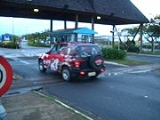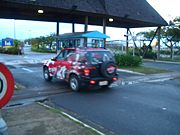
Rail transport in Fiji
Encyclopedia
Rail transport in Fiji exists to move cut sugar cane to crushing mills. There used to be two horse-drawn
street tramway systems, some other passenger systems, an underground mine system and some tramways on construction projects.
 Tramways have been used to transport sugar cane from the fields to the mill since 1876 when a 2.4 kilometres (1.5 mi) horse tramway was constructed on the Selia Levu estate on the island of Taveuni
Tramways have been used to transport sugar cane from the fields to the mill since 1876 when a 2.4 kilometres (1.5 mi) horse tramway was constructed on the Selia Levu estate on the island of Taveuni
. The Holmhurst Mill on Tavenui had tramways from 1882 of gauge
. A tramway was also built on Mago Island
.
Most cane tramways were of gauge, on the main islands of Viti Levu
and Vanua Levu
. Steam engines
were used, later replaced with diesel engines
. Most of the mills and tramways were built by the Colonial Sugar Refining Company
(CSR), an Australian-owned company, and transferred to the Fiji Sugar Corporation
in 1973, when CSR withdrew from Fiji.
Many lines were on road reserve provided by the government, and combined road-rail bridges were common. Some passenger services were provided, such as the famous Free Train from 1915, with one or two trains a week from Lautoka to Kavanagasau and Rarawai on the Rarawai-Kavanagasau Light Railway.
In 1988, according to Cane Train, there were 645 kilometres (400.8 mi) of permanent cane railway in Fiji, for the Lautoka and Rarawai, and Penang mill
s on Viti Levu, and the Labasa Mill on Vanua Levu.
The Coral Coast Railway Company on Viti Levu has operated return trips for visitors from Yanuca Island to Natadola Beach (16 km (9.9 mi) towards Nadi) from 1986, and also to Sigatoka
.
Horsecar
A horsecar or horse-drawn tram is an animal-powered streetcar or tram.These early forms of public transport developed out of industrial haulage routes that had long been in existence, and from the omnibus routes that first ran on public streets in the 1820s, using the newly improved iron or steel...
street tramway systems, some other passenger systems, an underground mine system and some tramways on construction projects.
Cane Trains

Taveuni
Taveuni is the third-largest island in Fiji, after Vanua Levu and Viti Levu, with a total land area of 435 square kilometers . The cigar-shaped island, a massive shield volcano which rises from the floor of the Pacific Ocean, is situated 6.5 kilometers to the east of Vanua Levu, across the...
. The Holmhurst Mill on Tavenui had tramways from 1882 of gauge
Rail gauge
Track gauge or rail gauge is the distance between the inner sides of the heads of the two load bearing rails that make up a single railway line. Sixty percent of the world's railways use a standard gauge of . Wider gauges are called broad gauge; smaller gauges, narrow gauge. Break-of-gauge refers...
. A tramway was also built on Mago Island
Mago Island
Mago Island is a volcanic island that lies in the northwest sector of Fiji's northern Lau Group of islands. One of the largest private islands in the southwestern Pacific Ocean, the pristine island consists of of land....
.
Most cane tramways were of gauge, on the main islands of Viti Levu
Viti Levu
Viti Levu is the largest island in the Republic of Fiji, the site of the nation's capital, Suva, and home to a large majority of Fiji's population.- Geography and economy :...
and Vanua Levu
Vanua Levu
Vanua Levu , formerly known as Sandalwood Island, is the second largest island of Fiji. Located 64 kilometres to the north of the larger Viti Levu, the island has an area of 5,587.1 km² and a population of some 130,000.- Geography :...
. Steam engines
Steam locomotive
A steam locomotive is a railway locomotive that produces its power through a steam engine. These locomotives are fueled by burning some combustible material, usually coal, wood or oil, to produce steam in a boiler, which drives the steam engine...
were used, later replaced with diesel engines
Diesel locomotive
A diesel locomotive is a type of railroad locomotive in which the prime mover is a diesel engine, a reciprocating engine operating on the Diesel cycle as invented by Dr. Rudolf Diesel...
. Most of the mills and tramways were built by the Colonial Sugar Refining Company
Colonial Sugar Refining Company (Fiji)
The Colonial Sugar Refining Company began operations in Fiji in 1880 and until it ceased operations in 1973, had a considerable influence on the political and economic life of Fiji. Prior to its expansion to Fiji, the CSR was operating Sugar Refineries in Melbourne and Auckland...
(CSR), an Australian-owned company, and transferred to the Fiji Sugar Corporation
Fiji Sugar Corporation
Fiji Sugar Corporation is the Government-owned sugar milling company in Fiji having the monopoly on production of all raw sugar in Fiji. It is also the largest public enterprise in Fiji directly employing nearly 3000 people while another 200,000 or more depend on it for their livelihood in rural...
in 1973, when CSR withdrew from Fiji.
Many lines were on road reserve provided by the government, and combined road-rail bridges were common. Some passenger services were provided, such as the famous Free Train from 1915, with one or two trains a week from Lautoka to Kavanagasau and Rarawai on the Rarawai-Kavanagasau Light Railway.
In 1988, according to Cane Train, there were 645 kilometres (400.8 mi) of permanent cane railway in Fiji, for the Lautoka and Rarawai, and Penang mill
Penang (Rakiraki) Sugar Mill
The Penang Sugar Mill in Rakiraki, Fiji is one of the four sugar mills operated by the Fiji Sugar Corporation. The FSC is the sole producer of raw sugar in Fiji.- History :...
s on Viti Levu, and the Labasa Mill on Vanua Levu.
Passenger Lines
In the 1970s a holiday resort on Malololailai Island in Nadi Bay built a short tramway from the air strip to the resort complex, using gauge equipment from the Fiji Sugar Corporation.The Coral Coast Railway Company on Viti Levu has operated return trips for visitors from Yanuca Island to Natadola Beach (16 km (9.9 mi) towards Nadi) from 1986, and also to Sigatoka
Sigatoka
For the banana disease, see Black sigatoka.Sigatoka is a town in Fiji. It is found on the island of Viti Levu and is situated at the mouth of the Sigatoka River, after which it is named, some 69 kilometers from Nadi. In Fiji's last census the population of Sigatoka was at 9622...
.

